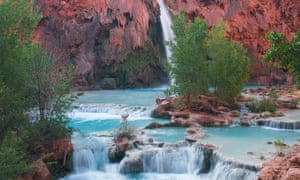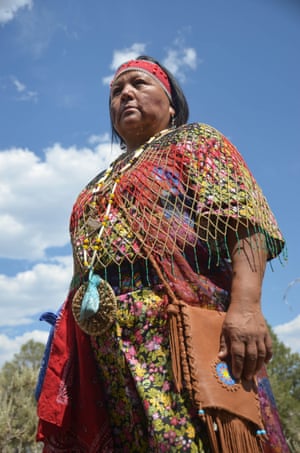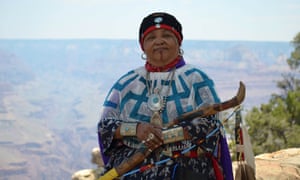The Havasupai are attempting to fight back against the operation of a uranium mine that they say could contaminate their sole water source.
by Joanna Walters in Supai Village, Arizona, July 17, 2017
Reposted from The Guardian.
Ed Tilousi knelt down next to the crystal-clear turquoise creek. The only sounds were the gurgling of the current and the sawing of cicadas in a pecan nut tree as the hot sun made the red rock canyon walls towering above him glow.
Downstream, the creek becomes a 100ft-high waterfall, tumbling into a brilliant blue pool then making more cascades before it empties into the Colorado river running through the Grand Canyon.
“The water talks to us, it has a voice you can hear all the time. We drink it, we depend on it. If it gets poisoned we are finished,” he said.
Tilousi is vice-chairman of the Havasupai Native Americans, a tiny community and the only one that lives within the depths of the Grand Canyon.
The sole water source in their remote home of Supai Village is the pristine creek. It comes from seeps and springs gravitating out of a vast aquifer, or natural underground reservoir, in the Arizona bedrock on the southern edge of the canyon.
The Havasupai water their beans, corn, melon, peach trees, horses and mules squeezed on to the strip of land they inhabit between the sandstone rock faces.
Tourists from all over the world snap up the limited number of visitor permits made available annually by the Havasupai and hike down a nine-mile trail in order to bathe in the fabled waters.
What they don’t realize is that way above, on that plateau of bedrock within the Grand Canyon watershed, sitting on top of the same aquifer, is a uranium mine preparing to go into production.
The mining company plans to drill down 1,475ft to extract high-grade uranium ore, then truck it 250 miles by road to their processing mill in Utah.
The Canadian company, Energy Fuels Inc, pledges to operate safely, but the Havasupai and others say that’s impossible to promise, especially as too little is known about subterranean water flow.
They argue that any contamination of the groundwater from the mining operations will end up in Havasu Creek, destroying an ancient way of life if they leave the canyon, sickening them if they stay. Significant pollution would also ruin the integrity of the waterfalls and could ultimately threaten the health of the 40 million people downriver who quench their thirst from the mighty Colorado River.
Tourism makes up 80% of the bare bones economy of Supai Village, Tilousi explained, generating income from the small campground and the basic lodge, cafe, grocery store and post office.
There’s a limited helicopter transportation service in this area, used by locals and less robust hikers, and one or two use an ATV, but little disturbs the rustic atmosphere.
“We used to have tourist flight-seeing planes from Las Vegas buzzing overhead, but we got onto the FAA and had that stopped. We sold our casino rights. That kind of commercialization will never happen here, we are the guardians of the Grand Canyon,” said Tilousi.
The Havasupai number only around 775 members, one of the smallest tribes in North America.
Tilousi had just returned from a peaceful demonstration near the mine.
Called Canyon Mine, it sits 45 miles east of Supai Village as the crow flies, and six miles south of Grand Canyon national park, on National Forest land.
In 2012 the Obama administration banned new uranium claims around the Grand Canyon watershed for 20 years.
A coalition of local leaders in northern Arizona and southern Utah recently requested the Trump administration lift the ban and expand mining access in the region, to the further horror of the Havasupai. Meanwhile, Canyon Mine can forge ahead because it was already established in the mid-80s, although mothballed before operations truly began, when the uranium market tanked.
The main shaft was drilled last year and the company is getting ready to supply the nuclear weapons and power industries.

At the demonstration last month, attended by Havasupai, neighboring Hualapai and Navajo families and environmental advocates, Ed had helped his elderly uncle, Rex, who uses a walker, get to the microphone stand.
Rex Tilousi, a former tribal chairman, sang songs in the Havasupai language as others beat drums and danced.
Then, pointing up the dirt track to the mine, he said: “I wish I was younger, because my get-up-and-go has got up and went. But I’m here to fight, because if you allow this to happen you will see sickness and deformities among our people in the future. We’ve seen the evidence.”
He was referring to the appalling legacy of decades of uranium exploitation on Navajo nation land, just a few miles to the east, where there are more than 500 abandoned mines. Companies extracted millions of tons of uranium across Navajo territory to supply demand for nuclear weapons during the cold war. Water sources were contaminated and clean-up of many old sites has been inadequate.
Disproportionate numbers of Navajo people have died prematurely of kidney failure and cancer, illnesses linked to uranium exposure, while government research has shown uranium has in babies born now, according to reports from the Centers for Disease Control and Prevention.
As Tilousi described the tribe opposition to the mine he choked up.
“One day I won’t be here, but maybe from behind a cloud I’ll look down and be able to say I’m proud of my people.”

Aside from fears about the environment, the Havasupai oppose the mine because it’s next to sacred ground.
For millennia, they farmed in the canyon in the summers then ascended on to the plateau for fall and winter, hunting and gathering across a vast territory where the sunlight, animals and firewood were more plentiful than down in the canyon during the colder, darker months.
And one of their most sacred sites “up top” was Red Butte Mountain, which can be seen for miles around and is close to Canyon Mine, and was where they held the demonstration and outdoor prayer gathering.
Many Native American tribes, including the Hualapai, Hopi and Navajo, consider it sacred. The Havasupai, in particular, believe it to be their spiritual umbilical cord connecting them to nature and the source of life.
But from the 1880s, the Havasupai were systematically driven off the plateau by an expansionist United States. Miners, soldiers and homesteaders attacked them, and the federal government forced them into a small section of the Grand Canyon and would not let them live elsewhere.
Although it was their canyon homeland, it could not support the whole community year round and the Havasupai had dwindled to as few as 200 by the late 1950s.
But they hung on and after relentless campaigning, the US Congress in 1975 expanded the Havasupai reservation to include part of the plateau again.

‘It’s 99.999% safe’
At the gathering, Rex Tilousi was exhausted after singing and giving a speech about his people’s history and what he now regards as the new existential threat they face. He sat down next to a young grandson, who was playing with a fidget spinner.
“The children are asking me ‘what is uranium? What can it do to us?’ I tell them that if it gets washed into the underground springs when the drills break it up, it can’t be cleaned out. The white man says it will be safe but they have lied to us in the past,” he said.
Also at the gathering, Colleen Kaska attended to her 91-year-old father, Daniel, who was weak and lying on cushions but still singing faintly along to the traditional songs.
Daniel Kaska is a legend among the Havasupai for persuading the community to refuse a payout from the federal government in the 1960s when it wanted to keep them off the plateau for ever.
But despite the 1975 expansion, Havasupai territory is only a fraction of what it once was and Red Butte Mountain is now on federal land.
“We had to get a permit from the Forest Service to hold this gathering at sacred Red Butte,” said Colleen Kaska, a US army veteran and tribal council member.
She is appalled that the Forest Service also gave Canyon Mine a permit and fears contamination not just in the water but via dust and the ore being trucked overland.
“Accidents happen, tornadoes, floods, hurricanes, road crashes, mistakes happen, that’s just life. Once a disaster occurs there’s no fixing it and there’s no going back,” she said.
Over at the Canyon Mine site itself, behind a chain link fence, director of operations Donn Pillmore agreed that mishaps can occur.
“Accidents happen,” he told the Guardian. “But there’s no way that anything we do can contaminate the Havasu springs area.”

His office is in a trailer. Outside, a truck was sprinkling water to help settle the dust. Next to the mine head machinery was a lined pond holding water that’s been pumped out of the main shaft, which unexpectedly became inundated earlier this year.
“It didn’t ever flood,” Pillmore said briskly. “We had excess water because of two weeks of heavy rains and three feet of snow.”
Small cannon on the edge of the pond were spraying plumes of the radioactive water removed from the inundated shaft into the air to evaporate in the hot sun. If the pond level gets too close to the brim to satisfy environmental regulations, as it has a number of times since the shaft filled with water at the end of the winter, the company evaporates some off and trucks the rest to its uranium processing mill.
Recent testing has shown that the contaminated pond water measures at 130 parts per billion, or a little over four times the environmental protection agency’s limits for safe drinking water of 30 parts per billion of dissolved uranium.
“We cannot release water from the pond,” he said.
Energy Fuels Inc is listed on the Toronto and New York stock exchanges. It had expected to be extracting ore by now, but operational delays mean that’s unlikely to happen before late 2017, the company has said.
“We are doing everything in our ability to operate in an environmental way. I’m an outdoorsman, I took my wife on honeymoon to the Grand Canyon in 1972, I love the canyon, the last thing I would do is anything that would harm the canyon,” he said.
Eleven people are currently working at Canyon Mine and round-the-clock production requires 54, Pillmore said. The company follows state and federal environmental regulations, he added, and the United States Geological Survey is drilling a monitoring well.
“There is zero risk. I guess you can’t say zero. It’s 99.999% safe … my conscience is clear,” he said.
Roger Clark, program director of the Grand Canyon Trust, an environmental advocacy group, countered: “That’s what BP said about Deepwater Horizon.”
He contradicted Pillmore to say that the mine shaft in fact was flooded at the end of last winter and much of it was because of a large underground pocket of water being breached.
Clark added that the USGS monitoring well is not deep enough to monitor the primary aquifer that supplies the Havasupai and also that industry best practice demands a minimum of three monitoring wells, which should be paid for by the company.
“All it would take to harm the Havasupai’s sole source of drinking water is contamination from the mine leaking into the aquifer,” he said. “It’s not just whether there’s an accident, it’s about the cumulative impact. Once you crack open the ore, uranium oxide is quickly dissolved by the water and can permanently pollute the aquifer. It may not show up for years, but the risk remains, even decades after the mine closes.”
The Havasupai, the Grand Canyon Trust and other environmental groups sued the Forest Service in 2013 for relying on old environmental studies when issuing Energy Fuels with its current permit, and for threatening a cultural site. The parties await the decision of the ninth circuit court of appeals, which ironically, is also mulling an appeal from the National Mining Association challenging the Obama administration ban. Rulings in the cases are expected this year.

Dianna Sue White Dove Uqualla, a former Havasupai council member and community health worker and now an elder of Supai Village, has followed the tribe’s legal battles on various fronts since she was a child.
Despite bouts of ill health she offered blessings and gently danced, braving record Arizona heat to wear her finest traditional garments.
“We are tired of being told where to go. I have learned not to yell and scream but just to tell the truth to people who are listening. We are very aware of what’s happening. The contamination will get us first but then everyone downstream is going to get sick,” she said.
Many wept at the gathering, some women cut locks of their hair and buried them on the mountain. Some complained that large corporations typically pollute first then walk away, challenging any claim about health problems in court and, at worst, paying a fine. Or sometimes going bankrupt and avoiding responsibility.
“The burden is always on us,” said Uqualla. At the least, advocates expect tighter regulations and new environmental assessments before operations can be permitted, but fear that in a Trump administration they will only become more lax.
Back down at the village after the four-day gathering, Uqualla cut fresh grass and brought water for her old horse, Morning Star.
“If we are meant to die here we will die here. When they kept us in the canyon they didn’t understand that we were living in Shangri-La. We’re not going to move,” she said.








